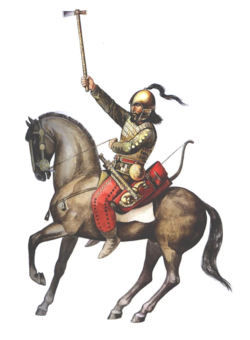Our website is made possible by displaying online advertisements to our visitors.
Please consider supporting us by disabling your ad blocker.
Orang Saka
Rencana ini mungkin boleh dikembangkan melalui teks yang diterjemah daripada rencana yang sepadan dalam Wikipedia Bahasa Parsi. (November 2023)
Klik [tunjuk] pada sebelah kanan untuk melihat maklumat penting sebelum menterjemahkan.
|

Bangsa Saka (bahasa Parsi Kuno: 𐎿𐎣𐎠 Sakā[1][2][3] bentuk moden: سَکاها Sakâhâ, Bahasa Yunani Kuno: Σκύθαι Skithai, bahasa Latin: Scythae[4]) adalah bangsa gembala berkuda serumpun bangsa Iran Barat[5] yang berpindah-randah[6] serata wilayah stepe Ukraine Timur, Rusia Selatan, Georgia, Armenia, Azerbaijan dan Asia Tengah pada zaman baharian klasik sampai berkerajaan sendiri di wilayah sekitar Asia Timur[7] dari 7 SM sampai 3 TM. Banyak maklumat ditemui dari catatan Historia karangan Herodotos sek. 440 SM serta sajak Epistulae ex Ponto karya Ovidius bahkan penemuan arkeologi menunjukkan adanya benda-benda indah dari emas yang ditemukan di tinggalan makam di Ukraine dan Rusia selatan.
- ^ West, Stephanie (2002). "Scythians". Dalam Bakker, Egbert J.; de Jong, Irene J. F.; van Wees, Hans (penyunting). Brill's Companion to Herodotus. Brill. m/s. 437–456. ISBN 978-90-04-21758-4.
- ^ Ivantchik, Askold (2018). "Scythians". Encyclopaedia Iranica (dalam bahasa Inggeris). Dicapai pada 2023-11-21.
- ^ "Old Persian Corpus". TITUS Texts. Universiti Frankfurt. Dicapai pada 2023-11-21.
- ^ Buku IV Naturalis historia karya Plinius yang Tua
- ^ Sulimirski 1985, halaman 149–153: "During the first half of the first millennium B.C., c. 3,000 to 2,500 years ago, the southern part of Eastern Europe was occupied mainly by peoples of Iranian stock [...] The main Iranian-speaking peoples of the region at that period were the Scyths and the Sarmatians [...]" Melyukova 1990, halaman 97–98: "From the end of the 7th century B.C. to the 4th century B.C. the Central- Eurasian steppes were inhabited by two large groups of kin Iranian-speaking tribes – the Scythians and Sarmatians [...]" Melyukova 1990, halaman 117: "All contemporary historians, archeologists and linguists are agreed that since the Scythian and Sarmatian tribes were of the Iranian linguistic group [...]" Davis-Kimball, Bashilov & Yablonsky 1995, halaman 91: "Near the end of the 19th century V.F. Miller (1886, 1887) theorized that the Scythians and their kindred, the Sauromatians, were Iranian-speaking peoples. This has been a popular point of view and continues to be accepted in linguistics and historical science [...]" Jacobson 1995, halaman 31–32: "Whatever their ultimate origins, by the time the Pontic Scythians settled in the region of the Black Sea, they almost certainly spoke an Iranian language [...]" Batty 2007, halaman 205: "The original Scythians, as far as we can tell, were Iranian-speaking nomadic pastoralists." Ivantchik 2018: "Scythians, a nomadic people of Iranian origin [...]" Dandamayev 1994, halaman 37: "In modern scholarship the name 'Sakas' is reserved for the ancient tribes of northern and eastern Central Asia and Eastern Turkestan to distinguish them from the related Massagetae of the Aral region and the Scythians of the Pontic steppes. These tribes spoke Iranian languages, and their chief occupation was nomadic pastoralism." Harmatta 1996, halaman 181: "[B]oth Cimmerians and Scythians were Iranian peoples." Sulimirski 1985, halaman 149–153: "During the first half of the first millennium B.C., c. 3,000 to 2,500 years ago, the southern part of Eastern Europe was occupied mainly by peoples of Iranian stock [...] [T]he population of ancient Scythia was far from being homogeneous, nor were the Scyths themselves a homogeneous people. The country called after them was ruled by their principal tribe, the "Royal Scyths" (Her. iv. 20), who were of Iranian stock and called themselves "Skolotoi" [...]" West 2002, halaman 437–440: "[T]rue Scyths seems to be those whom [Herodotus] calls Royal Scyths, that is, the group who claimed hegemony [...] apparently warrior-pastoralists. It is generally agreed, from what we know of their names, that these were people of Iranian stock [...]" Rolle 1989, halaman 56: "The physical characteristics of the Scythians correspond to their cultural affiliation: their origins place them within the group of Iranian peoples." Rostovtzeff 1922, halaman 13: "The Scythian kingdom [...] was succeeded in the Russian steppes by an ascendancy of various Sarmatian tribes — Iranians, like the Scythians themselves." Minns 1913, halaman 36: "The general view is that both agricultural and nomad Scythians were Iranian."
- ^ "Scythian". The New Encyclopædia Britannica, Micropædia. Volume. 10 (ed. 15th). m/s. 576.
member of a nomadic people originally of Iranian stock who migrated from Central Asia to southern Russia in the 8th and 7th centuries BC
CS1 maint: ref=harv (link) - ^ "Scythian mummy shown in Germany". BBC News. 24 August 2006. Dicapai pada 3 October 2010.
Previous Page Next Page


